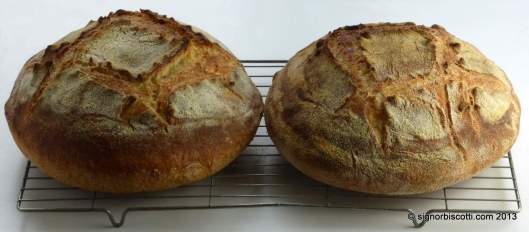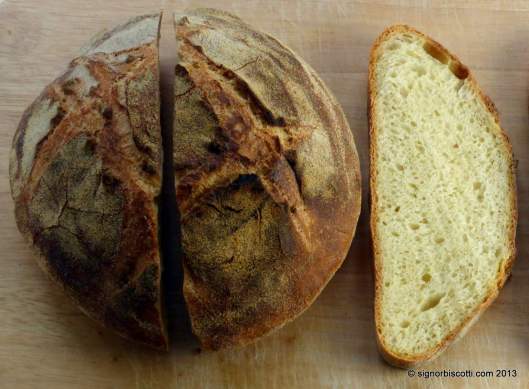Tags
Semolina is very confusing, as the same word is used to refer to a number of quite different things. In the UK it generally refers to a yellow, slightly grainy flour made from durum wheat, which is primarily used for making a simple but tasty milk pudding. It is not usually considered to be suitable for making bread, except when added as a small proportion of the total flour. But as you will see below, I have found that you can make beautiful bread using as much as 75% pudding semolina. It makes a lovely bread, with a primrose yellow crumb, a crunchy crust and a distinctive flavour.
And the confusion? Well first of all, even in the UK I have seen the name semolina applied to products made from other grains, usually normal wheat or rice. I have even seen a semolina that was effectively ground up bran (and it was every bit as horrid as it sounds). However, if your semolina is yellow, it is almost certainly the right thing.
But the muddle doesn’t stop there. The famous “semolina” breads of Italy, from Puglia and Sicily for example, are not in fact made with semolina (or semolino, as they call it), but with a more finely ground flour called semola di grano duro rimacinata. The key word here is rimacinata, which means re-milled, and it’s the re-milling of the semol(in)a that produces the finer texture. This flour is hard to find in the UK, especially where I live in rural Gloucestershire, but if you do see those magic words on a packet, snap it up. It is lovely stuff. You can use it on its own to make bread, and it is also great for pasta and pastry. Just in case you are lucky enough to have some, I have given a version of the bread using it below.
To add still further to the confusion, I believe that in the US you can buy “semolina flour”, which is in fact what we here call semolina. And there is also something called durum flour, which should be similar to semola rimacinata. However the “durum flour” I found for sale in the UK turned out to be (pudding) semolina.
To cut through all this mess, if you can find yellow pudding semolina or Italian flour labelled semola di grano duro rimacinata, you should be able to make one of the two recipes below. That “should” is because the pudding semolina version may be a bit of a gamble as I can’t guarantee your particular brand of semolina will work. I have successfully used both the Waitrose and Whitworth brands. But I’d urge you to give it a go, for what do you have to lose? A few pence and some of your time. What you will almost certainly gain is a beautiful bread with an exceptional flavour.
As you can see below, the loaves made with the two different flours turned out very much the same. The pudding semolina one was a little bit paler in colour and had a slightly rubbery texture. As it happens, my blind tasting panel (OK, my husband) thought it had the better flavour. But they were both delicious.
Ingredients
Makes 1 large loaf
For ingredients marked with a star* see notes above
For the Biga
| If using pudding semolina | If using semola rimacinata |
|
|
For the Dough
| If using pudding semolina | If using semola rimacinata |
|
|
Method
In a small bowl, mix together the biga ingredients, cover and leave at room temperature overnight or for up to 24 hours.
Combine the dry ingredients for the dough in a large bowl, then add the biga and water. Mix until all the flour has been incorporated.
Turn out onto an unfloured work surface and work it for 5-10 minutes, until smooth and elastic. The dough will feel strange and grainy to start with but it will soon develop into something much more familiar.
Put back in the bowl, cover and leave until at least doubled in size. This could take 3, 4 or even more hours.
Turn the dough out onto a lightly floured surface, pat out into a flat disc, then fold and reform into a ball. Dust the surface with flour, cover with the bowl and leave to rest for 10-15 minutes.
Turn the ball flour side down and repeat the flattening, folding and shaping into a ball. Dust a 1kg proving basket with semolina and do the same to the top of the ball of dough. Put it upside down in the basket, cover and leave to rise until doubled in size. This rise is likely to be faster than the first.
Preheat the oven to its maximum temperature (250C fan in my case).
There a number of ways you could bake this loaf.
 I used my 5 litre cast iron casserole, which I preheated along with the oven. When it was time to bake, I dusted the surface of the loaf with semolina, and then carefully tipped it into the bottom of the casserole. It doesn’t matter if it doesn’t go in quite straight, as it always seems to sort itself out in the oven.
I used my 5 litre cast iron casserole, which I preheated along with the oven. When it was time to bake, I dusted the surface of the loaf with semolina, and then carefully tipped it into the bottom of the casserole. It doesn’t matter if it doesn’t go in quite straight, as it always seems to sort itself out in the oven.
 I then scored it, taking even greater care not to burn myself on the side of the casserole (my fingered oven gloves came in handy here). Then I replaced the lid, put the casserole in the oven and reduced the temperature to 230C (fan). After 20 minutes I removed the lid, at which point the loaf was well risen but still soft and pale in colour. I gave it another 20-25 minutes, until it was well coloured and sounded hollow when tapped on the bottom.
I then scored it, taking even greater care not to burn myself on the side of the casserole (my fingered oven gloves came in handy here). Then I replaced the lid, put the casserole in the oven and reduced the temperature to 230C (fan). After 20 minutes I removed the lid, at which point the loaf was well risen but still soft and pale in colour. I gave it another 20-25 minutes, until it was well coloured and sounded hollow when tapped on the bottom.
You could of course prove and bake the loaf in a tin. A good sized 2lb / 900g one would be about right (so called 2lb tins do come in wildly different sizes). I have also successfully used a 20cm round cake tin. Or you could simply turn the loaf out onto a baking tray. If not using a casserole, it would be a good idea to preheat a roasting tin in the bottom of the oven and throw some water into it when you put the loaf in.
I am submitting this post to Panissimo, a bimonthly collection of breads from around the world, run by Barbara from Pane e Companatico (Bread and What-goes-with-it) and Sandra from Indovina chi viene a cena? (Guess who’s coming to dinner). This month it is hosted by Simona from Briciole, and the theme is Special and Ancient Flours. I hope that Pudding Semolina qualifies!





I so much enjoyed reading this post! I also have troubles finding rimacinata here and I agree about the confusion with the names: I once mistakenly used semola (instead of semola rimacinata) to make bread and the loaf was kind of tough to chew on. what they here call durum flour is much finer and makes better bread. you can also get the pudding semolina, very popular among old Italuan filks as semolino, in Sweden but I had no idea bread could come out of it. and not any bread… Beautiful – and it also looks soft differently from my bread made with semola. You invented something new and I am so proud to have this bread in Panissimo and even more to have it participating to the monthly theme, thank you! Barbara
Thank you Barbara. I’d forgotten about semolina = semolino. lol!
Very nice loaf!
I am not used to bake with semolina, tried a few times but haven’t had good results.
This recipe is going straight to my bread recipes folder 😉
Who knows, maybe one day I’ll bake such a beautiful semolina loaf!
Have a lovely day
Lou
Thank you Luisa. This bread has become a household favourite so I hope you’ll like it too.
Beautiful! I can get rimacinata at the Italian deli in Bristol, Licata’s in Picton Street, The terminology of flours is so confusing isn’t it? I like the golden colour of the crumb. Do you find the crusts are quite ‘sharp’ with rimacinata? it is one of the characteristics I have noticed. Another lovely bread to make with a hot soaker of pudding semolina is a BBQ bun of Dan Lepard’s which we are very fond of, one of his Guardian recipes. Anyway you have inspired me to go flour shopping !
Thanks Joanna. Yes it does have quite a sharp edge on the breaks, but not lethal like some baguettes. I did wonder if rimacinata might be easier to find in a big city. As it happens Bristol is only about an hour away from here and I might follow up your recommendation of Licata’s. I bet they’ve got lots of other things to tempt me! I shall look into Dan’s BBQ bun recipe. His bread recipes always have an unusual twist.
Looks absolutely beautiful! I can’t wait to give it a try!
Thank you Alex. I look forward to seeing how you get on.
First thing yesterday in the morning was going to Italy (the border is only half an hours drive away) to buy semola di grano duro rimacinata (among other goodies)
to make occhi siciliani
but smaller ones + they look lovely
but
I did not read the explanations properly + used too much yeast + so they taste a bit yeasty but I will try them once more + also this recipe, the bread looks great!
thanks
lamassu
Oo, I wish I could just pop over the border to buy some rimacinata! Anyway, thank you, and I’m pleased that you tried the occhi siciliani. They are one of my favourite breads, and not just because they remind me of my time in Sicily 🙂
Very interesting post. I don’t think they sell pudding semolina in the US. We only have semolina flour. Both loaves look beautiful! Thanks for contributing to Panissimo.
Thanks Simona. It’s a very confusing subject isn’t it? Your braided walnut and raisin loaf looks stunning!
I’ve always wondered about semolina flour and have used pudding semolina in the past as part of a recipe. Great explanation. And now those gloves are on my wish list too.
The gloves are great! Thanks for your tweet recommending my post, Sally.
I heard about the storm in UK, hope you both are well (+ the cats too)
Thank you for your concern. Despite the forecast, the storm passed us by, although it did come pretty close.
I’ve been looking everywhere for semolina flour. Yesterday i was in my local Indian supermarket and lo and behold huge bags of semolina both fine and coarse. Cheap as chips as well!! Bought the fine one: sole ingredient listed as durum wheat. going to give it a go.
Excellent! I suspect that even the fine is not as fine as rimacinata, so I’d be inclined to treat it as if it were pudding semolina until you see how it behaves. Unless you’re feeling really experimental of course! Good luck either way, Either way, I’ll be very interested to know how it goes.
e un piacere vedere una tua ricetta nella nostra raccolta. GRAZIE.
Sandra
Grazie Sandra. Mi e’ piaciuto tanto partecipare a Panissimo che diventa sempre piu’ impressionante.